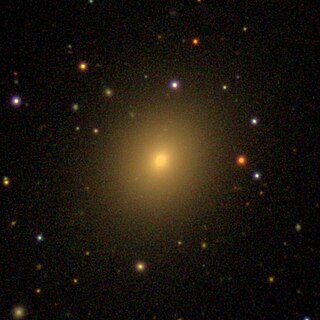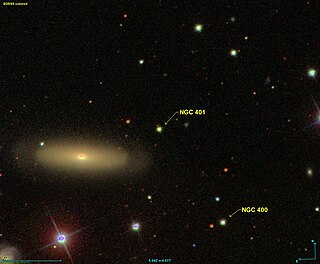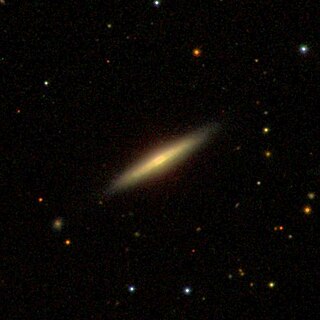
Messier 88 is a spiral galaxy about 50 to 60 million light-years away from Earth in the constellation Coma Berenices. It was discovered by Charles Messier in 1781.

The Collinder catalogue is a catalogue of 471 open clusters compiled by Swedish astronomer Per Collinder. It was published in 1931 as an appendix to Collinder's paper On structural properties of open galactic clusters and their spatial distribution.

NGC 1535, also known as Cleopatra's Eye, is a planetary nebula in the constellation of Eridanus, discovered by William Herschel on February 1, 1785. It is very similar to the Eskimo Nebula in both color and structure but the central star can be quite difficult to observe visually. The object is included in the Astronomical League's Herschel 400 Observing Program.

NGC 156 is a double star located in the Cetus constellation. It was discovered on 1882 by Ernst Wilhelm Leberecht Tempel.

NGC 202 is a lenticular galaxy located in the constellation Pisces. It was discovered on November 17, 1876 by Édouard Stephan.

NGC 203 is a lenticular galaxy located approximately 233 million light-years from the Solar System in the constellation Pisces. It was discovered on December 19, 1873 by Ralph Copeland.

NGC 207 is a spiral galaxy roughly 178 million light-years from the Solar System in the constellation Cetus. It was discovered on December 7, 1857, by R. J. Mitchell.

NGC 233 is an elliptical galaxy located in the constellation Andromeda. It was discovered on September 11, 1784 by William Herschel.

NGC 276 is a barred spiral galaxy located approximately 626 million light-years from the Solar System in the constellation Cetus. It was discovered in 1886 by Frank Muller and was later also observed by DeLisle Stewart.

NGC 378 is a barred spiral galaxy located in the constellation Sculptor. It was discovered on September 28, 1834 by John Herschel.

NGC 777 is an elliptical galaxy in the constellation of Triangulum. It was discovered by William Herschel on September 12, 1784. It has a weak active nucleus of type Seyfert 2 or LINER 2, implying that the central region is obscured. It may be an outlying member of galaxy cluster Abell 262.

NGC 367 is a spiral galaxy in the constellation of Cetus. It was discovered in 1886 by the astronomer Frank Muller.

NGC 370 is a triple star located in the constellation Pisces. It was recorded on October 7, 1861, by Heinrich d'Arrest. It was described by Dreyer as "very faint, 13th magnitude star 15 arcsec to south, diffuse." However, there is nothing there. It is now presumed to be either a lost or "non-existent" object, although it is possible it could be a duplication of NGC 372.

NGC 400 is a star located in the constellation of Pisces. It was discovered on December 30, 1866, by Robert Ball.

NGC 401 is a star located in the constellation of Pisces. It was discovered on December 30, 1866, by Robert Ball.

NGC 416 is a globular cluster located in the constellation Tucana. It was discovered on September 5, 1826, by James Dunlop. It was described by Dreyer as "faint, pretty small, round, gradually brighter middle". At a distance of about 199,000 ± 9,800 ly (61,000 ± 3,000 pc), it is located within the Small Magellanic Cloud. At an aperture of 31 arcseconds, its apparent V-band magnitude is 11.42, but at this wavelength, it has 0.25 magnitudes of interstellar extinction.

NGC 489 is probably an edge-on spiral galaxy located about 97 million Light-years away from Earth in the constellation Pisces. NGC 489's calculated velocity is 2507 km/s. NGC 489 was discovered by German astronomer Heinrich Louis d'Arrest on December 22, 1862.

NGC 3675 is a spiral galaxy located in the constellation Ursa Major. It is located at a distance of about 50 million light years from Earth, which, given its apparent dimensions, means that NGC 3675 is about 100,000 light years across. It was discovered by German-British astronomer William Herschel on 14 January 1788. NGC 3675 belongs to the Ursa Major Cluster, part of the Virgo Supercluster.

NGC 4531 is a spiral galaxy located about 50 million light-years away in the constellation Virgo. It was discovered by astronomer William Herschel on April 17, 1784. NGC 4531 is a member of the Virgo Cluster.

NGC 2074 is a magnitude ~8 emission nebula in the Tarantula Nebula located in the constellation Dorado. It was discovered on 3 August 1826 by James Dunlop and around 1835 by John Herschel. It is described as being "pretty bright, pretty large, much extended, [and having] 5 stars involved".



















